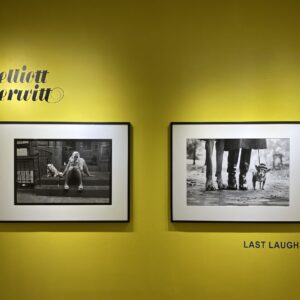JTF (just the facts): A paired exhibition of photographs, paintings, and other ephemera, hung against pink and green walls, and installed in a series of rooms on the second floor of the museum. The show was organized by Mia Fineman. (Installation shots below.)
The following works are included in the exhibition:
Walker Evans
- 12 gelatin silver prints, 1933-1934, c1934/c1970, 1941, 1941/c1970, sized roughly 5×7, 6×6, 6×5, 8×10, 7×11, 9×7, 10×8, 7×8 inches
- 7 Polaroid SX-70 prints, 1974, sized roughly 3×3 inches
- 17 film negatives (shown on video screen), 1934, 1941, 1950s, 1968
- 1 film transparency (shown on video screen), 1960s
- 29 postcards (from the collection of Walker Evans), 1910s-1030s, sized roughly 4×6 inches each
- 4 tempera on paper, oil on high density fiberboard, c1958, sized roughly 19×16, 13×10, 16×20 inches
- (vitrines): 1 magazine spread, 1942; 1 magazine spread, 1961; 1 photobook, 1942
Anastasia Samoylova
- 1 inkjet print, 2021, 40×59 inches
- 2 inkjet prints, 2020, 40×50 inches
- 8 inkjet prints, 2018, 2019, 2020, 2021, 40×32, 32×40 inches
- 9 inkjet prints, 2017, 2019, 2020, 2021, 16×20, 20×16 inches
- 2 inkjet prints with acrylic on canvas board, 2024, 20×16 inches
- 4 inkjet prints with acrylic on canvas board, 2023, 2024, 14×11 inches
A monograph of this paired body of work was published in 2022 by Steidl (here). Clothbound hardcover, 30.5 x 26.2 cm, 192 pages, with 144 image reproductions. Includes an essay by David Campany and a short story by Lauren Groff. (Cover shot below.)
Comments/Context: The title of this exhibit, Floridas: Anastasia Samoylova and Walker Evans, offers its essential duality right up front. For some visitors who wander into its rooms, it will obviously be a show about the first word – Floridas – as a subject, as seen in both black-and-white and color photographs made across almost a century. For others, the exhibit will instead focus on the two names – Samoylova and Evans – providing an opportunity to observe an artistic dialogue between two photographers from different generations, using common subject matter as a way to make a set of stylistic comparisons and visual echoes clearer. From either vantage point, the show functions effectively, mixing equal parts cultural history and aesthetic interpretation.
That first word choice, and its plurality, is worth thinking about further – Floridas. It implies that there is not just one monolithic Florida but many discrete Floridas, which of course there are, especially when we tick off the stereotypical signifiers that we quickly bring to mind when thinking about this unique American place. There’s the Florida of lush tropical beauty, filled with jungle greenery and exotic wildlife, like alligators, flamingoes, and pelicans. There’s another of warm sandy beaches and sun splashed tourist hotels, aspirationally built to attract warm weather seeking visitors from the North. A third Florida might be the orange grove agricultural Florida and its juicy fruits, once given as treasured holiday gifts. And yet another might be the Art Deco Florida of the 1950s, with its stylized pastel architecture and endless rows of palm trees. But of course, these visions of paradise were then (and still are now) equal parts fantasy and reality.
While Walker Evans was undeniably artistically rooted in the northeastern United States (particularly Connecticut), he did make a surprising number of trips to Florida during his long career, as evidenced by the some six hundred images made in the state to be found in the Evans Archive at the Met. He first visited Florida in 1934, on a commission to photograph a resort in Hobe Sound, and he returned in 1941 for a longer stint, road tripping from Tallahassee to Sarasota working on the images to illustrate a book tiled The Mangrove Coast: The Story of the West Coast of Florida. Additional visits took place to his sister’s house on Anna Maria Island in the 1950s, and for another commission, making photographs of the Rybovich Boat Works for Fortune magazine in 1961. There are even some late Polaroids from Florida in the archive, made on his last trip to the state in 1974.
Chronologically, this show actually begins before Evans’s first visit to Florida, in the form of early 20th century penny picture postcards of Florida that he had collected. As a side hobby to photography, Evans was a passionate postcard collector, amassing over nine thousand vernacular images of everyday America, and the selections here provide a visual baseline for the “Old Florida” myths to which both artists in this show are responding. The cards capture both the elegant and the eccentric, from fancy hotels, golf courses, and newly built communities to oddball ostrich farms, swamp tours, and ocean sponge varieties. As promotional items, the postcards document a range of leisure activities and welcoming vistas, reminding us that glass-bottomed boat tours, beach cabanas, and the famous green benches of St. Petersburg are only a short trip away from wherever we might be.
Set against what we already know about Evans, the elegant economy of his documentary eye, and his enduring interest in vernacular American culture, particularly storefronts and roadside signage, his images from Florida fit neatly within our expectations – they look like the kind of photographs we think Walker Evans would have made in Florida. He notices the weathered verticality of both an ancient banyan tree and the columns of a Greek Revival house. He sees all kinds of people with precision – winter resorters, businessmen in hats, shuffleboard players, and African-American women outside a modest wooden house. He finds the overlooked quirks of the region, from the ornate bandwagons of the Ringling Bros. circus and the cluttered setups of trailer-camps to a sponge diver’s suit, a bait shop (where he crafts a shadow self-portrait), a few curio arrangements, and various painted murals and billboards. He makes boldly cropped abstractions of boats and sign lettering. And perhaps most surprisingly, Evans actually tries his hand at a few paintings while in Florida, flattened compositions of beach shacks and boat prows, seen with a simplifying almost Precisionist eye that seems to echo the aesthetic of the murals he was seeing nearby. Along the way, Evans is quietly and consistently unflinching in his observations, capturing the everyday contradictions and performative facades of mid-century Florida life almost wherever he looked.
But interestingly enough, this Florida story doesn’t really begin with Evans. Instead, we need to jump forward several decades, and actually start with Anastasia Samoylova. Samoylova is a Russia-born naturalized American citizen who got her MFA in Illinois in 2011 (as an international student) and ultimately moved to Miami in 2016 to more actively pursue her career in photography. Samoylova’s early images were almost Cubist in their layering of disorienting space, made from tabletop arrangements of imagery filled with mirrored reflections and abstracted geometries. But her move to Florida seems to have inspired a more intentional look outward, and in the next few years, she made photographs road tripping around the state, leveraging her sophisticated eye for color and spatial distortion and applying it to observational scenes drawn from the surroundings. The images she made ultimately took shape as the 2019 photobook FloodZone (reviewed here), which smartly intermingled the pastel colors of the Floridian fantasy with the encroaching reach of climate change, where frequent flooding, pervasive rot, and delusional building have become the norm. A handful of years later, it remains a standout photobook that stylishly wrestles with the uncomfortable realities of a warming world.
While Samoylova was researching potential shooting locations around Florida for her road trips, she stumbled upon the digital Evans archive on the Met website, and unearthed his Florida work. She ultimately visited a few places where he had made pictures decades earlier, and while not exactly “following in his footsteps”, she certainly identified a like minded artistic companion for her journeys. Some of her own images that didn’t make the cut for FloodZone for one reason or another ended up as the beginnings of another Florida project, this one with more direct connection to Evans and the pictures she had found. Samoylova eventually acquired permission from the Met to use some of the images from the Evans archive in her 2022 photobook Floridas, but to be clear, her edit came long before the one on the walls here; only after a serendipitous meeting with Met curator Mia Fineman at an art fair did this show start to take shape, and its form and sequencing is somewhat different than that of the original photobook.
In many ways, this was a somewhat pre-packaged show concept (that Samoylova had already crafted) that was easy for the Met to like and accept. Not only did it leverage its vast Evans holdings (and activate them in a clever and historically intriguing way), it offered the double positive of an exhibit addressing current events (climate change, Florida’s changing political culture, etc.) as seen by an up-and-coming female photographer. This isn’t something the Met has done particularly consistently or well in the recent past; in fact, Samoylova is the first female photographer to get a meaningful show in her lifetime since Helen Levitt in 1992.
One overly simplistic way to see this show is that it offers an insightful “before” and “after” story of Florida – Evans before the real explosion of tourism and expansion and Samoylova after the hangover of that growth has now been felt. Both photographers are ostensibly working in an observation or documentary mode, but their aesthetics are decently divergent. Evans, working in black-and-white, is straightforward, reserved, and aloofly curious, taking in the quirks and curiosities of Florida with the formal precision of an outsider. Samoylova’s largely color works have a different kind of controlled tension and dynamism, her strongest compositions confusing us with their visual layering and encouraging her charged contemporary discoveries to linger in a more unsettled mood, which likely better represents how she feels as a resident watching the world around her starting to unravel.
Samoylova’s image of an upside down house is perhaps the most literal depiction of the tumult in the warm Florida air. The polarized political atmosphere in contemporary Florida takes shape in several of her pictures: a house flying an upside down American flag, a shirtless man with “No Mercy” and a pair of handguns tattooed on his chest, a roadside gun shop with a machine gun mural, and a Trump poster with the face blacked out by dark strips. Stark climate realities shape still other images, with flooded courtyards and rotting buildings providing seductively reflective surfaces for Samoylova to visually play with. But the empty beach lots where houses once stood (all destroyed by Hurricane Michael in 2018, save one) are an eerie reminder of what happens when Mother Nature is disregarded; the new condominiums dropped right into the otherwise pristine jungle offer yet another example of head-scratching climate-flaunting delusion. Perhaps the most grimly puzzling image in the show features a baby alligator left in a tiled pool with a slim drip of water; the pastel hues of pink and light blue make for a cheery palette, but if this is the life we’re offering the inhabitants of “Gatorama”, it’s clear we’ve collectively lost our way.
Samoylova’s most optically confusing compositions, like “Venus Mirror, Miami” and “Pointe Mall, Orlando”, are among her best, with reflection, tints, flattened spaces, and other visual layering coming together to create densely packed frames filled with competing textures, motifs, and colors. A few of these images bring commercialism and consumption more directly into the discussion, weaving looming faces from advertisements and painted murals into the fabric of the city. Of course, Evans was intrigued by vernacular murals as well, and a rich back-and-forth develops between the two artists as images of painted walls and billboards collapse the decades separating them.
And just as this exhibit offers the revelation of Evans the painter, Samoylova also extends her own approach with some overpainting and collage techniques. For Evans, the painterliness leads to simplification, where formal elements are reduced to evocatively clean approximations; for Samoylova, the instinct seems to be toward extension and breakdown, where photographs provide a starting point for additive painting that amplifies the expressiveness of the works – photographic scenes are extended and embellished, creating more opportunities for the dissolving decay and painterly interpretation she wants to communicate.
While the Evans photographs on view here won’t be remembered as among his most durably resonant, they certainly provide a useful counterpoint to Samoylova’s contemporary perspectives. Seen together, the show offers a combined photographic portrait of Florida that is richly complex, with much more potential for friction and contradiction than our usual visual clichés of the state would normally permit. Samoylova deserves credit for not only finding her own original photographic voice in the thick Florida humidity, but for bringing Evans back into the conversation so thoughtfully. In many ways, she has been rewarded with a rare show at the Met for understanding (and demonstrating to those paying attention) that a careful and nuanced engagement with photographic history can enrich a contemporary photographic practice. Her success here highlights just how confidently she has learned that standing on the shoulders of giants isn’t something to be afraid of.
Collector’s POV: Since this is a museum exhibition, there are of course no posted prices.
Evans’s prints are routinely available in the secondary markets, with dozens of prints coming up for auction every year, mostly later prints and broken up portfolios. Recent prices have ranged from $1000 to nearly $400000, with vintage prints of his most iconic images at the top end of that range.
Samoylova is represented by Dot Fiftyone Gallery in Miami (here), Galerie Caroline O’Breen in Amsterdam (here), Wentrup Gallery in Berlin (here), Galerie Peter Sillem in Frankfurt (here), and Sabrina Amrani Gallery in Madrid (here). Her work has little secondary market history at this point, so gallery retail likely remains the best option for those collectors interested in following up.







































